|
Dr. Leo Semashko, Sociologist, President, Global Harmony Association (GHA), St. Petersburg, Russia The ABC of Social Harmony. Global Tetrasociology of a Harmonious Civilization in the 21st Century: Rejection and Attraction Paper for the Russian Congress of Sociology, Ufa, October 23-25, 2012 Abstract: This paper is devoted to the pluralistic tetrasociological theory of social harmony and harmonious civilization, developed since 1976, which was most fully reflected in the collective book of the author and his 75 co-authors from 26 countries: "The ABC of Harmony." Key words: ABC of harmony, social harmony, Tetrasociology, Tetrism, global peace, harmonious civilization, tetranet harmonious thinking The ABC of Harmony and its Meaning for Sociology and Society The ABC of Harmony for World Peace, Harmonious Civilization and Tetranet Thinking, Global Textbook, by Dr. Leo Semashko, Project Manager, Editor in chief and GHA 75 coauthors from 26 countries: first is published in English in India, New Delhi, Doosra Mat Prakashan, 2012, 334 pages, ISBN – 978-81-923108-6-2. The book is submitted also in the two electronic formats: www.peacefromharmony.org/?cat=en_c&key=478 – HTML and www.peacefromharmony.org/file/6079/ABC_of_Harmony_eng.pdf - PDF. The authors’ 27 reviews are at: www.peacefromharmony.org/?cat=en_c&key=489 The book may be ordered at: www.peacefromharmony.org/?cat=en_c&key=508. The ABC of Harmony is represented on all continents in the libraries of hundreds of educational institutions: schools, colleges and universities, as well as at the GHA members and friends in dozens of countries. The ABC of Harmony was prepared within GHA in 2011 and published in early February 2012 in Russian in St. Petersburg and in English in New Delhi, India. Among its 76 co-authors are prominent scientists, peacemakers, artists and politicians: former President of India, Dr. Abdul Kalam; architect of Ronald Reagan’s economic reform, Dr. Norman Kurland; head of the international organization of doctors (IPPNW), which received the Nobel Peace Prize in 1985, Prof. Ernesto Kahan; Chancellor of the Pedagogical IASE Deemed Gandhi University, Kanak Mal Dugar; Catholic Professor and the UN agent, Dr. François Houtart; President of World Esperanto Association, Prof. Renato Corsetti; President of International Association of Educators for World Peace, Prof. Charles Mercieca; President of International Forum for Literature and Culture of Peace, Prof. Ada Aharoni; Secretary General of "World Constitution and Parliament" Association, Prof. Glen Martin; prominent Russian Professors: Vladimir Bransky, Gregory Tulchinsky, Alexander Subetto, Dimitry Ivashintsov and many others. Five co-authors have the, GHA highest honorary title: World Harmony Creator as explained at http://peacefromharmony.org/?cat=en_c&key=513. The ABC of Harmony is the first in the world and history the global textbook on social harmony for all nations, presidents and the UN. The presentation of this book at the International Seminar of teachers in New Delhi February 11, 2012 marked the beginning of a new era of humanity - the Age of Harmonious Enlightenment and Education, which aims to overcome the total ignorance of the past history in social harmony (www.peacefromharmony.org/?cat=en_c&key=511). Of course, like all first, the ABC of Harmony is far from perfect, it is still in an embryonic state, and as a theory, and as an empirics. But it opens up a fundamentally new way of social thinking in the 21st century. It was the first time an alternative to traditional, private, and partly sociological theories in general, i.e. sociology of industrial civilization, broken into hundreds of branch parts, helpless in the whole scientific picture of outgoing, industrial civilization, and a new, harmonious one. The ABC of Harmony unfolds the global sociology as science of this civilization - Tetrasociology, developing more than 35 years. This science is its necessary spiritual prerequisite, which precedes and is ahead its to light scientific nonviolent conscious development of this civilization. If for spontaneous and because violent industrialism sociology is not required (so it drags like its appendage with a very little use), then harmonism can be born and grow only consciously and scientifically, without that it is impossible in principle as non-violent civilization. By this Tetrasociology is fundamentally different from industrial sociology. Therefore, the prominent American philosopher Prof. Glenn Martin defined the quality of Tetrasociology and its The ABC of Harmony as "The fundamental revolution in science and paradigm shift in human consciousness, … as Our New Planetary Paradigm " [1, p. 296]. This article is a synopsis of Tetrasociology from this ABC with the system using tetramodels as the tools of tetranet harmonious thinking [1, p. 67-79]. Conscious Nature of a Harmonious Civilization Changes of historical civilizations occurred spontaneously and were accompanied by violence such as wars, revolutions, riots, terrorism, and so on. The cardinal difference of a harmonious civilization from all the past civilizations is its conscious birth and development. The first of its self consciousness and identification is the GHA book, "Harmonious Civilization" [2], signed for publication on November 3, 2009. This date is recognized in the GHA as the birth day of the harmonious civilization. The growth of the conscious understanding of civilizational shift characterizes a number of international conferences 2010/11. A new civilization begins to realize itself at once in different spiritual dimensions and in different sciences. The transition from intuitive to scientific understanding of the new social reality is expressed by conscious creation of the ABC of Harmony, which begins purposeful development and application of scientific thinking of a new civilization. Model-1. The main feature of a harmonious civilization
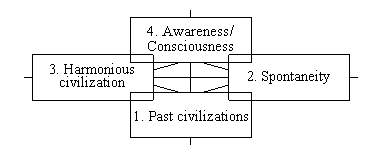
Birth of Harmonious Civilization/Noosphere in 2009 The preparation and birth of a harmonious civilization has occurred throughout the entire history of mankind. Harmonious civilization is inevitable as the single way for survival and sustainable development of humanity. It is evidently. In a special article provides a list of about 70 facts of spontaneous global harmonization [2, с. 13-20]. In 2009, this trend was identified by three events of world importance that allow us to define the birth of the global harmonious civilization in that year: 1.The nuclear disarmament up to "zero" between the U.S. and Russia that would be impossible in a militaristic industrial civilization; 2.The emergence of the first conscious theoretical model in the GHA program book "Harmonious Civilization" [2], which first introduced its alphabet, language and thinking; and 3.The conscious formation of mathematics of harmony in the fundamental book of Prof. Alexey Stakhov in 2009 [3], in which he and his followers laid down the arithmetic of a new civilization. The first economic confirmation of a new civilization can be recognized by the unprecedented philanthropy of 40 American billionaires in 2010, an act that denies all the economic laws of industrialism and is explicable only in harmonism. This is the beginning of an economy of self-limitations of the new civilization. These four events are now the four cornerstones of this harmonious civilization. Social confirmation of the harmonious civilization at the regional level occurred with the creation of the European Union in 1992 as well as China, building, albeit still rather intuitively rather than knowingly, a harmonious society in its territories, with a population of around 2 billion people – almost the third of humanity – since 2006. These facts allow us to state that humankind entered the threshold of a harmonious civilization/noosphere and a new "axial age" (Karl Jaspers) [4] as well as into its own inevitable future. Model-2. The first signs of a harmonious civilization since 2009
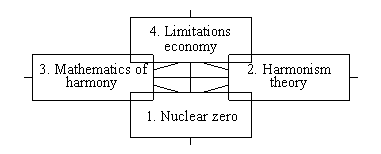
Spheral Code of Social Harmony The ABC unfolds the deep structure of social harmony. Its code cannot be represented by hundreds of branches of industrialism or millions of its firms. Social harmony is rooted not in them and at the level of societal spheres at the utmost large parts of society ensuring its complete harmony at the deepest structural level. Therefore, all the ABC fundamental elements are spheres, the harmony of which defines the harmony of all their industries/branches and other smaller pieces. The spheres, because of their utmost large scale, are not available through the physical senses but only through a theoretical vision. This is in contrast to the parts of the industrial society – industries, corporations, firms, and so on – that can be experienced through sensory perception. Therefore, the spheral structures and elements are deep and invisible, while, on the surface, only certain small parts are visible. Therefore, harmonious civilization requires learning to think by the spheres but not in industries/branches. This requirement is fully met by the ABC of Harmony. only on this level can a harmonious way of thinking about harmonious wholeness of society and individuals be achieved. By only spheres are expressed the deep structure of the code of social harmony. Model-3. Codes of industrialism and harmonism 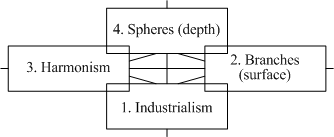
The most short definition of the alphabet of harmony: It is the 20 fundamental, necessary, sufficient and coherent elements/spheres of society that express the most deep structure of social harmony and define the infinite variety of its manifestations. Axiom of Social Harmony Axiom of social harmony: The harmonious existence of a society in any place and at any time is defined by four necessary and sufficient resources: - People (P), - Information (I), - Organizations (O) and - Things (T). (Things are any material benefits and services). These resources are expressed in the chain: People (P) – Information (I) – Organization (O) – Things (T). In the acronym: P-I-O-T, or: PIOT. Five Clusters of Harmony Elements The ABC of Harmony consists of five necessary, sufficient and coherent groups/clusters of the fundamental elements of social harmony: resources – processes – structures – classes – individual/human. PIOT's basic resources are in a closed cycle of the processes from their production, where they arise, through their distribution and exchange to consumption, where they disappear. PIOT resources, together with their closed processes, create the structures/organizations or spheres of their production and consumption. The people employed in these structures comprise the large groups of the population and make the relevant spheral classes and spheral social structure of any society. PIOT resources, as a social macrocosm, are impressed in microcosm of the individual/human as its internal similar complex of spheral resources, defining his/her life and harmony. All the infinite variety of objects, structures, properties and relations of the social world are summarized in these five clusters and reduced to it. Therefore, the ABC, which includes them, is universal for the social world. The ABC embraces its diversity, which aspires to harmony as a sustainable development of this world and the most optimal state of it. The clusters of harmony elements are inseparable, interrelated and coordinated, resulting in a notion of coherence. ontologically, epistemologically and dialectically, the harmony and all clusters of its elements are coherent, i.e. they agree in their inseparable interrelation, which creates integrity/wholeness of any social harmony on any level. Model-4. Five clusters of the ABC of Harmony 
Tetra-structure of Clusters The ABC clusters have tetradic (four-field, four-dimensional) structure: each contains the four different elements. This structure is the most adequate and sufficient for the expression of harmony and its integrity at every level of the social world. The tetra-structure of clusters determines the harmonic content of tetranet thinking. It is fundamentally different from disharmonious and partial industrial thinking based on the triadic structures [1, с. 17-20]. The tetra-structures are as ancient as the world. Pythagoras, Empedocles, Plato and many other thinkers of all cultures and times to the present time have described them [5, 23–30]. But just at present, in this era of birth of a harmonious civilization, they are required to be used as the basic cells of a fundamentally new, harmonious, tetranet thinking. It is therefore not surprising that the ABC of this thinking has tetradic structure. The clusters' tetra-structure corresponds to the tetra-structure of the elements of harmony, which provides them mutual inclusion according to the fractal principle: "all are in all." This structure defines the highest qualities of harmony in which its integrity/holism and completeness are both ontologically and epistemologically found in harmonious thinking. Interdependence of these qualities as well as their relevant concepts are expressed by the chain and tetramodel-5: harmony – tetra-structure – harmony integrity – harmony fullness. Model-5. Qualities of harmony 
Necessary, Sufficient and Coherent Nature of Harmony Elements Integrity and fullness of harmony are specified and detailed in the necessity and sufficiency of its elements. The necessity and sufficiency is the strongest logical argument on which is built the logical consequences. The ancient and best example of this necessity and sufficiency of the four elements was distinguished by the sages of ancient Greece who identified land, water, air, and fire. Each of these elements is necessary. Correspondingly, the absence of any one of them makes life on Earth impossible. only together do they make up the sufficient conditions for life's existence. The logic of necessity and sufficiency of the ABC's five clusters of harmony and their 20 elements is similar. This is the fundamental characteristic of the harmony elements. The necessity and sufficiency of the elements are inseparable from their coherence, consistency and proportionality. But if the first two qualities (necessity and sufficiency) of the elements reflect the impossibility of the existence of each element separately, without the others, then coherence expresses them in coordination and proportional dependence of each element from the others. Therefore, the harmony of the elements is expressed through the relationship of the three inseparable qualities: necessity, sufficiency and coherence. Model-6. Qualities of elements of harmony
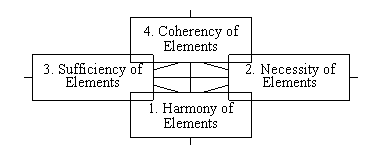
Cluster 1: Resources The main cluster of fundamental elements of social harmony in its ABC consists of four spheral PIOT resources. They are defined by the axiom above. Each spheral resource is empirically evident on a superficial level, but, as a whole, they are invisible and require theoretical definition in a static state outside of motion. This creates the social statics of harmony. PEOPLE are the priority social resource and harmony actor because they possess the unique quality (ability) to make all other resources, including themselves. People include all human beings from the moment of birth as all the human population. Zero population/people is a zero of society, a situation that expresses the necessity of this element. The same logic of necessity is for three other social resources: zero each have zero society that expresses the necessity of these elements. In PIOT, another important feature is coherency and their mutual inclusion as "all in all" or "everyone in every one." This means that each of these resources includes and cannot exist without the participation of all other resources. The priority among these resources the one determines the quality of each resource, and only that circumstance allows us to carry it to one of the four classes of resources. This ontological feature of resources is the cause of the epistemological difficulties and errors of classification of resources. Internal and external coherence of PIOT resources determines their internal and external social harmony. A more detailed description of these resources, their dialectics and their different priority are presented in the book [6, 186–200]. Model-7. PIOT Resources
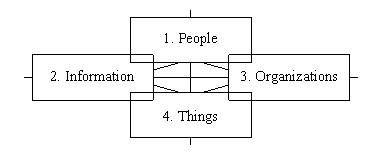
Cluster 2: Processes None of the PIOT resources is found in nature as a finished and ready-made product. Therefore, a society and individuals are compelled to reproduce them continuously throughout their entire life from birth to death. This is known as reproductive employment [5, 35–46]. As Adam Smith and Karl Marx showed, each PIOT resource passes four necessary and sufficient processes of reproduction: - Production (P), - Distribution (D), - Exchange (E) and - Consumption (C), They constitute a closed cycle from the emergence of the resource in production until its disappearance in consumption. The PDEC processes represent extremely large functional spheres of social relations that constitute the social dynamics of harmony. The PDEC processes are coherent and mutual inclusive, that is, production of any product requires consumption of all PIOT resources in certain proportions. Harmony of social resources and harmony of social processes (functions and relations) are mutually dependent on each other, but the primary role play PIOT resources. Through their harmony is expressed the harmony of PDEC process in their knowledge and statistical expression (see below). Model-8. PDEC Processes

Cluster 3: Structures PIOT resources are inseparably connected with PDEC processes, forming the fundamental social structures of four spheres of social reproduction. They differ in the final product/resource that they produce. The PIOT resources are the subject and the product of the four necessary, sufficient and coherent structures/sphere of social reproduction: - Social sphere, or Sociosphere (S), the subject and the product of which are people (P); - Information sphere, or Infosphere (I), the subject and the product of which is information (I); - Organizational sphere, or Orgsphere (O), the subject and the product of which are organization/s (O); - Technical (economic/ecological) sphere, or Technoecosphere (T), the subject and the product of which are things (T). The SIOT structures are extremely large social systems, which are called spheres of reproduction and constitute the social structuratics of harmony. These spheres combine old PIOT resources and PDEC processes for reproduction of new PIOT resources. These spheres are inseparable, coherent and mutual inclusive, so no one sphere of production cannot exist separately from the other spheres. Therefore, they are equally necessary, which means that no one is more primordial than the others. They produce a similar from similar through others, that is, every PIOT product is made from the appropriate resource(s) with and through other resources. These spheres define the structure of social needs, abilities, employment, labor, property, money, distribution, exchange/market, consumption, and so on. SIOT structures are structures of reproduction not only in society with all its resources and processes but also the social harmony of the whole together with them – if they are coherent. But if the SIOT structures are disharmonious and insufficiently coherent, as in an industrial society, they reproduce social disharmony as a whole. Therefore, harmonious development of society is dependent on the harmonious development of its SIOT spheres in their unity and coherency of mutual limitations. Model-9. SIOT Structures 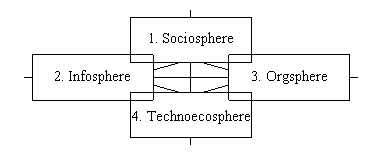
Cluster 4: Classes SIOT spheres cover the entire population. They include each person from birth to death. All personal life activities are represented as reproductive employment in these spheres and change (replacement) of this sphere employment in time. It is a whole universal reproductive employment for the entire population and for every individual. Therefore, the eternally existing SIOT spheres divide the entire population, without exception, into four eternally existing spheral classes. The population classes occupied (employed) in the SIOT spheres of social reproduction are: - SOCIOCLASS, people who are employed in the sociosphere; - INFOCLASS, people who are employed in the infosphere; - ORGCLASS, people who are employed in the orgsphere; - TECHNOCLASS, people who are employed in the technoecosphere (economical/ecological sphere). The abbreviation of these classes is the same as for the structures (Cluster 3), so we will differentiate them by adding the word "class" to these: "SIOT-classes." The SIOT classes are differed not in particular or temporal attributes of private property (like Marx) or stratification (as in empirical sociology) but in universal spheres of the SIOT employment. Employment in these spheres is key criterion for these classes. Therefore, they are referred to as SPHERAL classes of the population (SIOT-classes). The spheral classes of the population are universal, necessary, sufficient and coherent as is the case with spheres in which they are employed. Therefore, they are the primary and permanent actors of social harmony. However, antagonistic economic classes (Marx) constantly exist on the surface to dominate the industrial civilization, determine its disharmonious nature and neutralize the spontaneous harmony of spheral classes. They become the full actors of social harmony, when they become conscious, based on knowledge of alphabet (ABC), language and thought of harmony. This occurs in a harmonious civilization, which they consciously create and constantly reproduce. The human simultaneously belongs to all classes, as each day he/she is busy in each sphere even for a minimum of time. However, at each life stage, the sphere that takes the most of an individual's time has a priority. At each life stage, the individual's class identification (class membership) is determined by this criterion. Therefore, the spheral classes are "soft," without distinct economic and other boundaries, and do not prevent them from being the most profound and fundamental to the social harmony as a whole. In contrast and on the surface of society, there are also people who are historically transient and limited in both class and group structures; these are known as partial classes or groups. The partial classes/groups dominate in all disharmonious civilizations that have preceded the harmonious one. The consequence of their presence (or even dominance) in every sphere is suppression of and violence toward other spheres and classes. We find four forms of these partial classes/groups: 1. Economic, which is realized by the economically dominant classes and applies not only to other spheres and classes but also to nature. Economic suppression is the priority in industrialisms and manifests itself in continuous wars of trade and competition. 2. Political, which is made by the politically dominant classes and is manifested in the continuous political wars, violent revolutions and wars between states. 3. Information, which is realized by the informational dominant classes and is manifested in continuous derogatory or defamatory information designed to divide the population and create ideological wars. 4. Social, which is made by the socially dominant classes and is manifested in the continuous wars over religion, gender, inter-generations and so on as well as in genocide. These wars are often accompanied by the use of weapons, crises, and degradation, which ultimately lead to the destruction of the whole (including those who created the wars) and creation of a new separate, evolved state or civilization such as the demise of the industrial civilization and the rise of the harmonious civilization. The suppression by other spheres and classes, i.e. society in general, by the partial classes first occurs through violence and war. This is the first sign of a typical social pathology and disharmony. It is the manifestation of ignorance of harmony – the necessary coherence – of all spheres and sphere classes. In contrast, the conscious spheral classes – those owning a basic ABC understanding of harmony as well as the language, thinking, and theory of harmony – will create a society that excludes all forms of violence of the partial over the whole. Together with the SIOT spheres, the SIOT-CLASSES constitute a deep social structure in a whole or deep structure of social harmony in a whole. During the pre-harmonious history of humankind, they acted as spontaneous, intuitive and unconscious actors of harmony. They have since become conscious actors of a harmonious civilization, mastering scientific knowledge of the ABC of social harmony. Therefore, today, there is a differentiated spontaneous and conscious cultivation of harmony by society and the individual. SIOT-CLASSES define the social occupatics of harmony or universal occupation/employment by harmony. The term "occupatics" is made from an English word "occupation," which means any employment or any kind of activity. Model-10. SIOT Classes

The considered four clusters of elements of harmony express society in a whole and its integral harmony on all levels. Inseparability and the relationship between these elements are represented graphically in Scheme-1 – Socionome (below). Cluster 5: Human Society cannot be understood without humans and vice versa. They relate both as macro- and micro- cosmoses, just as do the atom and the universe or the drop and the ocean. Therefore, society and the human are the same in their fundamental, deep, spheral structure. To the four spheres of society (SIOT) correspond the four fundamental spheres of reproduction/life of each individual/human: - CHARACTER (orientation, values and morals); - CONSCIOUSNESS (information and spiritual culture); - WILL (individual order and self-organizing); and - BODY (anatomy, temperament, subconsciousness and physiology). To the four spheres of human (CCWB) correspond the four kinds of individual needs, abilities, work, employment, property, distribution and exchange. The spheres of the individual are interconnected. Therefore, harmonious development of an individual is a harmonious development of these spheres in their unity and coherency of mutual limitations. The individual spheres represent the extremely large psycho- socio- physio complexes that define individual structuratics of harmony. The human spheres (CCWB) are also as necessary, sufficient and coherent as the society spheres (SIOT), which are an external extension and embodiment of the internal individual spheres. The SIOT spheres of social harmony are not possible without the CCWB spheres of individual harmony and vice versa, which means that the individual spheres are included in the elements of social harmony. Model-11. Individual Spheres
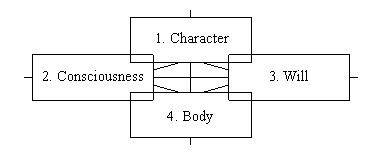
Socionome of a Society and Psynome of a Man as Integral Images of Society and Man in the ABC of Harmony
The elements of social and individual harmony mentioned above need to be integrally summarized and to have a united image so that each of 20 the elements will find its own place in a holistic and logically organized structure. The best similitude for such a structure is the genome. The ABC of Harmony deals with two genomes: the social genome of the society, which we will call by means of a new term, SOCIONOME, and the psychological genome of the human, which we will call by means of another new term – PSYNOME. The Socionome of a Society is the social genome of any society represented by the integral summary of 16 fundamental interrelated elements/spheres of social harmony, which constitute the deep structure of society in whole and guarantee its stable life. The Psynome of a Man is the psychological genome of a man or woman represented by the integral summary of four fundamental interrelated elements/spheres of individual harmony that constitute the deep structure of man in whole and guarantee his/her stable life. Socionome and psynome are similar in structure but different in consisting elements. Socionome and psynome express their fundamental dialectical and harmonious properties: coincidence, identity in the deep structure of society and man. But they differ and contrast in elements, filling this structure at the level of society and at the level of man. Socionome and psynome are represented in large graphical, integral schemes. The first scheme is below, the second, similar, is presented in the book [1, 44–45]. Definitions, Explanations and Notes to the Socionome. Definitions: 1. Socionome of a Society is the social genome of any society represented by the integral summary of 16 fundamental relative elements/spheres of social harmony that constitute the deep structure of society in general and guarantee its stable life. 2. Social Harmony is the consent (adequacy, proportion, coherence) of any sphere of society as a part within the whole and in regard to other spheres or parts. 3. Harmonization of Society assigns the property of consent to all interrelations of the elements/spheres of society, as represented in the scheme. Explanations to the Socionome: 1. This scheme demonstrates four equally necessary and, together, sufficient spheres of any society as its eternal structural-functional frame, which I called: the socionome of society. 2. The socionome of society is similar to the eternal psychological genome of a man (see below) because the macrocosm is similar to the microcosm. 3. Production and consumption processes are represented in one module of the scheme that expresses their continuity and coincidence: production is consumption and vice versa. 4. Exchange as a market, where demand and supply meet, is a spontaneous regulator of harmony (balance) of four spheres of social production, which turns into a conscious, much more effective regulator of social harmony along with its knowledge. Notes to the Scheme-1: 1. The similar Scheme was first created in 1980, more than 30 years ago. But it hasn't been published anywhere for all this time. Its updated version was first published in the ABC of Harmony (2012), where it takes its logical place as the integrator of all elements of the social harmony [1, 40-41]. 2. The Scheme-1 represents two ontological levels: society and nature, which is planet Earth for a man. In the upper part, there is society in a whole; in the lower part, it is represented as the part of nature in the form of noo- or anthroposphere of Earth in the integrity of its seven spheres. 3. The Scheme-1 demonstrates well that the spheres are the elements of not just social but also of natural harmony. That is why harmony of nature and society passes not through the branches of society but through its spheres interacting with the spheres of Earth. Interaction of every social sphere with the spheres of the Earth is demonstrated in the Scheme. Death of at least one natural sphere means inevitable death of society. The previous century has shown that it is only disharmony of society and man that passes and enlarges through the branches. Consequently, scientific understanding of the global ecological problem is possible not at the level of disharmonious branch thinking of the previous century but at the level of harmonious spheral (tetranet) thinking of the new century. The ABC of this thinking consists of 20 fundamental spheres as the elements of harmony. It teaches to think with the harmony of spheres but not with the disharmony of branches. 4. The Scheme represents two levels of thinking: structural (the level of four spheres) and functional (the level of the interactions between four spheres), which logically transforms into a technological level, including IT, by means of the statistical matrix of spheral indices [1, 51-53; 7]. The Scheme covers the objects of harmonization (16 elements) and the technology of their harmonization by means of special statistics and mathematics (ibidem). 5. The Scheme-1 is an integral, holistic model of any social level, from global to family (in some modifications also to atomic – individual), where any positive and negative social processes from ideal harmony to collapse of society may be modeled. 6. Scheme-1 is the most important tool of knowledge and conscious governance of social harmonization at any level; hence this Scheme is an organic part of the ABC of Harmony, its knowledge and practical application. 7. Discovery of the socionome is equal to the transformation of sociology to the level of fundamental theoretical science of society in a whole to the level of Tetrasociology as the science of social harmony. Sociology turns from narrowly empiric science to the fundamental theoretical science, connecting all of its broken branch parts in a one whole. 8. Socionome is extremely important not just for sociology but for all social sciences. It is known that, in disharmonious and partial industrial society, they correspondingly develop partially and disharmoniously. It makes them weak in the face of integrity and harmony of the relevant spheres and areas: economics, politics, culture, law, management, and so on. Discovery of the socionome enables every corresponding science to transform from the limited and narrowly empiric science to the fundamental, theoretical science and to overcome interdisciplinary barriers. In this case, such sciences become harmonious and integral and holistic. They rise to the level of thinking not by branches but by spheres. It is a new level of social thinking as a whole. SOCIONOME:
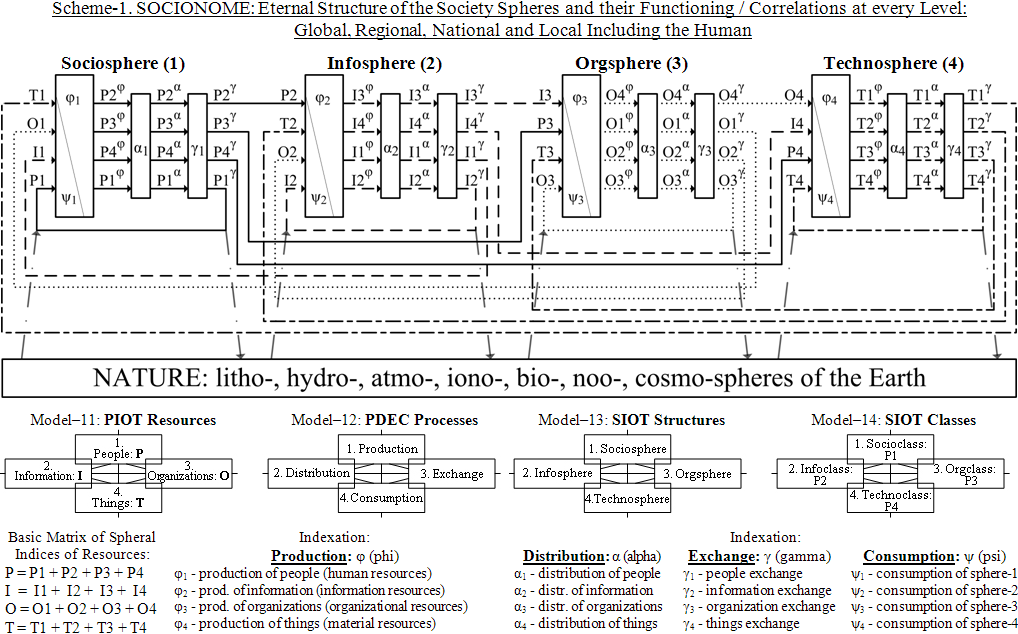
Rejection and attraction It is well known: the old rejected a new one that is born within it. Industrial society and sociology reject a harmonious society and its Tetrasociology. This situation is illustrated throughout its history of over 35 years. Tetrasociology attraction creates a process of global harmonization and the birth of a harmonious civilization. The ABC of Harmony opens this civilization by the harmonious global sociology in the 21st century and the Age of Harmonious Enlightenment in this sociology. It generalizes the other works devoted to harmony [3; 8; 9; 10; and etc.]. References 1. Semashko, Leo together with the GHA 75 coauthors from 26 countries (2012) The ABC of Harmony for World Peace, Harmonious Civilization and Tetranet Thinking.Global Textbook. New Delhi: Doosra Mat Prakashan. 2. Semashko, Leo together with the GHA 119 coauthors from 34 countries (2009) Harmonious Civilization. Global Harmony Association Innovative Projects, St-Petersburg: LITA 3. Stakhov, Alexey (2009) The Mathematics of Harmony. From Euclid to Contemporary Mathematics and Computer Science. Canada: World Scientific. 4. Jaspers, Karl; Bullock, Michael (Tr.) (1953) The Origin and Goal of History (1st English ed.). London. 5. Semashko, Leo (2002) Tetrasociology: Responses to Challenges. St.-Petersburg: Polyt. University. 6. Semashko, Leo (1999) Sociology for Pragmatists, St.-Petersburg: European House. 7. Semashko, Leo (2000) Tetrasociology as the Revolution of Social Thinking, the Way of Harmony and Prosperity. St.-Petersburg: LITA 8. HRH The Prince Of Wales; Tony Juniper; Ian Skelly (2010) Harmony: A New Way of Looking at Our World, London: Harper Collins Publishers, Blue Door 9. Brahma Kumaris Spiritual University (1993) Universal Harmony, India 10. Baimuratov, Uraz (2010) Harmony of Society and Economy: Global Paradigm, Almaty
27/08/12
----------------------------------------------------------
Up
|